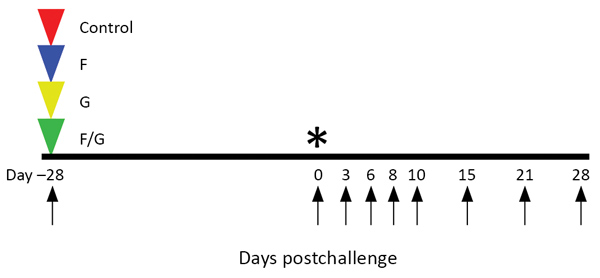Volume 25, Number 6—June 2019
Research
Use of Single-Injection Recombinant Vesicular Stomatitis Virus Vaccine to Protect Nonhuman Primates Against Lethal Nipah Virus Disease
Figure 1

Figure 1. Groups of African green monkeys (Chlorocebus aethiops) receiving recombinant vesicular stomatitis virus (rVSV) vaccine against Nipah virus Bangladesh strain (NiVB). Triangles indicate days of vaccination; arrows indicate days of sampling; and asterisk (*) indicates day of challenge. Red indicates control group (GInd*rVSV-ΔG-GFP expressing no glycoprotein); blue indicates F group (GInd* rVSV-NiVB/F-GFP expressing the NiVB F protein); yellow indicates G group (GInd*rVSV-NiVB /G-GFP expressing the NiVB G protein); F/G group (single-cycle infectious virions with NiVB F and G proteins on the cell surface). F, fusion; G, attachment
1Current affiliation: Mayo Clinic, Rochester, Minnesota, USA.
Page created: May 20, 2019
Page updated: May 20, 2019
Page reviewed: May 20, 2019
The conclusions, findings, and opinions expressed by authors contributing to this journal do not necessarily reflect the official position of the U.S. Department of Health and Human Services, the Public Health Service, the Centers for Disease Control and Prevention, or the authors' affiliated institutions. Use of trade names is for identification only and does not imply endorsement by any of the groups named above.